
Welcome to the homepage of the lecture
Correspondence Problems in Computer Vision
Winter Term 2012/2013
Home
About Us
People
Teaching
Research
Publications
Awards
Links
Contact
Internal
Correspondence Problems in Computer Vision
Computer Science Teaching Award (summer term 2008)
Instructor:
Markus Mainberger
Office hours: Thu 16-17 c.t.
Examiner:
Prof. Dr. Joachim Weickert
Winter Term 2012/2013
Lectures (2h) with programming/theoretical exercises (2h)
(6 credit points)
Lectures: Thursday, 14-16 c.t., Building E1.3, SR 016
Tutorials: Monday, 16-18 c.t., Building E1.3, SR 014 (theory) / CIP 104
(programming)
First lecture: Thursday, October 18, 2012.
First tutorial: Thursday, October 25, 2012.
Synopsis – Prerequisites – Registration – Contents – Assignments and Turorials – Self-Test Problems – Exams – References
Example - Stereo Reconstruction
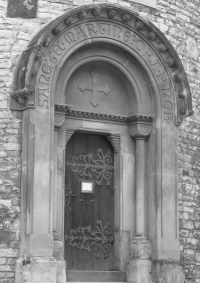 |
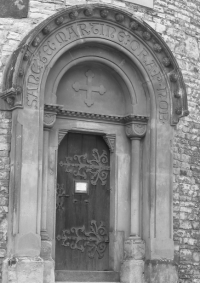 |
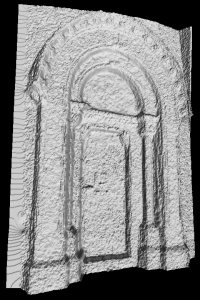 |
Example - Motion Estimation
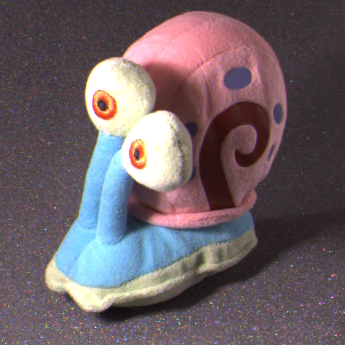 |
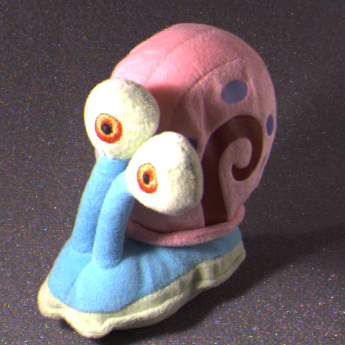 |
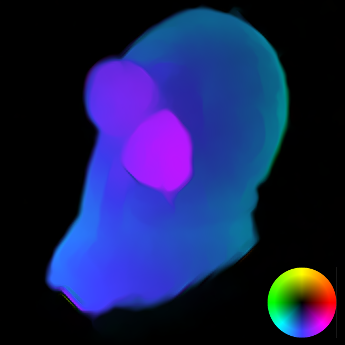 |
Correspondence problems are a central topic in computer vision. The basic
task amounts to identifying and matching corresponding
features in different images/views of the same scene. Typical examples for
correspondence problems are (i) the estimation of motion information from
consecutive frames of an image sequence (optic flow), (ii) the reconstruction
of a 3-D scene from a stereo image pair and (iii) the registration of medical
image data from different image acquisition devices (e.g. CT and MRT).
The central part of this lecture is concerned with discussing the most important
correspondence problems together with suitable algorithms for their
solution.
This class is particularly useful for those students who wish to
to pursue a master thesis in our group in the field of computer vision.
Suited for students of visual computing, applied mathematics and computer science. Requires undergraduate knowledge in mathematics (e.g. ''Mathematik für Informatiker I-III'') and elementary C knowledge (for the programming assignments). Knowledge in image processing or differential equations is useful. The lectures will be given in English.
Registration is closed.
Course material will be made available on this webpage in order to
support the classroom teaching and the tutorials, not to replace
them. Additional organisational information, examples and explanations
that may be relevant for your understanding and the exam are provided
in the lectures and tutorials. It is solely your responsibility
- not ours - to make sure that you receive this information.
The following table shows a preliminary list of topics that will be
covered during the semester.
| Date | Topic | Slides | Slides, version to print |
|---|---|---|---|
| 18/10 |
Lecture 1: Introduction, Overview |
[download] | [download] |
| 22/10 |
Lecture 2: Block Matching, Correlation Methods, Occlusion Detection, Interest Points, Feature Methods + Programming Assigment 1 (P1) |
[download] | [download] |
| 08/11 |
Lecture 3: Optic Flow I: Local Differential Methods, Parametrisation Models + Theoretical Assigment 1 (T1) |
[download] | [download] |
| 15/11 |
Lecture 4: Optic Flow II: Global Differential Methods, Horn and Schunck + Programming Assigment 2 (P2) |
[download] | [download] |
| 22/11 |
Lecture 5: Optic Flow III: Advanced Constancy Assumptions, Large Motion + Theoretical Assigment 2 (T2) |
[download] | [download] |
| 29/11 |
Lecture 6: Optic Flow IV: Advanced Data and Smoothness Terms + Programming Assigment 3 (P3) |
[download] | [download] |
| 06/12 |
Lecture 7: Optic Flow V: High Accuracy Methods + Theoretical Assigment 3 (T3) |
[download] | [download] |
| 13/12 |
Lecture 8: Optic Flow VI: Advanced Numerics + Theoretical Assigment 4 (T4) |
[download] | [download] |
| 20/12 |
Lecture 9: Stereo Matching I: Projective and Epipolar Geometry + Programming Assigment 4 (P4) |
[download] | [download] |
| 10/01 |
Lecture 10: Stereo Matching II: Estimation of the Fundamental Matrix + Theoretical Assigment 5 (T5) |
[download] | [download] |
| 17/01 |
Lecture 11: Optic Flow + Stereo: Scene Flow Estimation + Programming Assigment 5 (P5) |
[download] | [download] |
| 24/01 |
Lecture 12: Medical Image Registration: Mutual Information, Elastic and Curvature Based Registration, Landmarks + Theoretical Assigment 6 (T6) |
[download] | [download] |
| 31/01 |
Lecture 13: Particle Image Velocimetry: Div-Curl-Regularisation, Incompressible Navier Stokes Prior + Programming Assigment 6 (P6) |
[download] | [download] |
| 07/02 |
Lecture 14: Summary, Outlook |
[download] | [download] |
There will be weekly tutorials, alternating between programming and theory:
Monday, 16-18 c.t.,
Building E1.3, SR 016 (theory) / CIP 104 (programming)
As part of the tutorials, assignments are offered.
Both, programming and theoretical assignments
will be solved and discussed in the tutorials.
Working in groups of up to 3 people is permitted.
The only requirement for the admission to the exam is
the regular attendance of the tutorials. You will not
be allowed to take part in the exam if you miss more than two tutorials.
Both, the source code needed for the programming assignments as well as example solutions for all the assignments will be provided on this page during the semester.
| Date | Assignment | Example Solution | Code |
|---|---|---|---|
| 25/10 | P1: Blockmatching | [download] | [download] |
| 12/11 | T1: Sub-Pixel Refinement, Taylor Linearisation, Minimization of the Lucas/Kanade Method | [download] | |
| 19/11 | P2: Horn and Schunck Method | [download] | [download] |
| 26/11 | T2: Motion Tensor Notation, Affine Horn and Schunck, Photometric Invariants | [download] | |
| 03/12 | P3: Gradient Constancy and Backward Registration | [download] | [download] |
| 10/12 | T3: Dataterm Robustification, Gauss-Seidel with Warping | [download] | |
| 17/12 | T4: Smoothness Terms | [download] | |
| 07/01 | P4: Coarse-to-Fine Warping | [download] | [download] |
| 14/01 | T5: Fundamental Matrix, Stereo Reconstruction | [download] | |
| 21/01 | P5: Fundamental Matrix Estimation | [download] | [download] |
| 28/01 | T6: Variational Optic Flow with Epipolar Term | [download] | |
| 04/01 | P6: Mutal Information | [download] | [download] |
The followning problems should resemble a typical exam. You will have 2 hours (120
minutes) time to solve them without using the lecture notes or other auxiliary
material. You can achieve 30 p. in total, so you have 4 minutes per point.
| Self-Test Problems | Self-Test Problems - Solutions |
There will be closed book, written exams.
The first written exam takes place on Friday, February 15 from 10 to 12 AM
in Building E1.3, Lecture Hall 002.
The second written exam takes place on Friday, March 01 from 10 to 12 AM
in Building E1.3, Lecture Hall 002.
In order to qualify for the exams attendance of the tutorials is mandatory.
You will not be allowed to take part in the exam if you miss more than two
tutorials. In case of qualification, you are allowed to take part in
both exams. The better grade counts.
The results of the first written exam
can be found
here, and the corresponding
distribution of points and grades
here.
Each student who has participated in the first written exam had the
opportunity to inspect his/her graded solutions in room 4.05 in Bldg. E1.7 on
Thursday, February 21th, 2013, between 11:00 am and 18:00 pm
The results of the second written exam
can be found
here, and the corresponding
distribution of points and grades
here.
Each student who has participated in the second written exam has the
opportunity to inspect his/her graded solutions in room 4.05 in Bldg. E1.7 on
Tuesday, March 5th, 2013, between 11:00 am and 18:00 pm
NEWS:
the cerfificates (Scheine) for COPCV
can be obtained from our secretary
Mrs. Ellen Wintringer,
Building E1.7, Room 4.22.
There is no specific book that covers the complete content of this class. Many lectures will be based on articles from journals and conferences. However, the following three books cover most topics:
- Optic Flow
A. Bruhn: Variational Optic Flow Computation: Accurate Modeling and Efficient Numerics.
Ph.D. Thesis, 2006. Available from /bruhn/PhDThesis.pdf
- Stereo Reconstruction
L. Valgaerts: Variational 3D Reconstruction from Stereo Image Pairs and Stereo Sequences
Ph.D. Thesis, 2011. Available from http://www.mpi-inf.mpg.de/~valgaerts/pubs/valgaerts_phdthesis.pdf
- Medical Image Registration
J. Modersitzki: Numerical Methods for Image Registration. Oxford Press, 2003.
MIA Group
©2001-2023
The author is not
responsible for
the content of
external pages.
Imprint -
Data protection